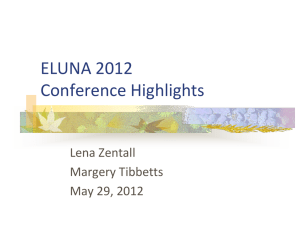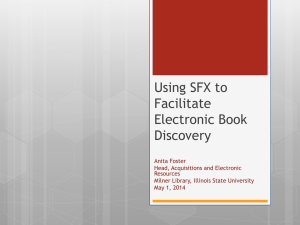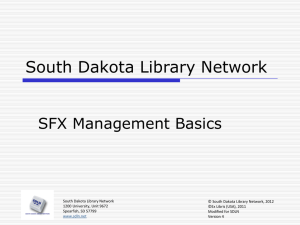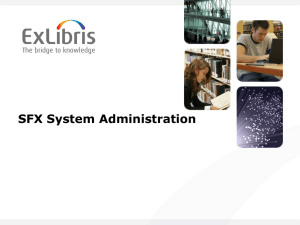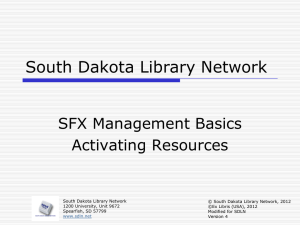SFX Statistical Reports - Ideals - University of Illinois at Urbana
advertisement
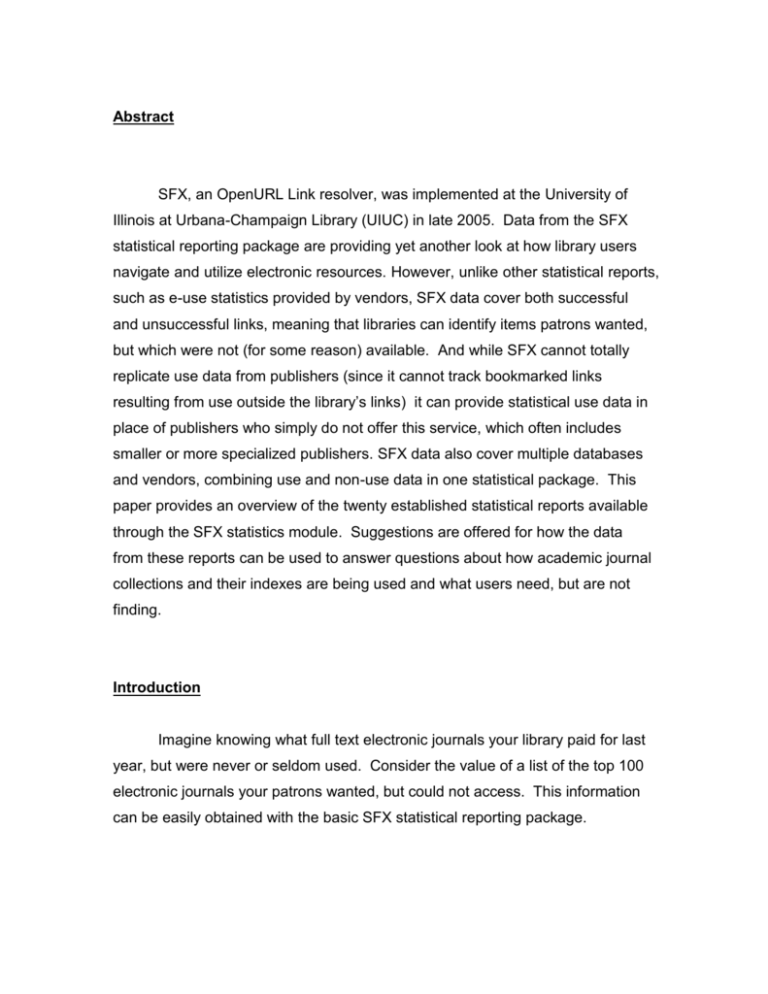
Abstract SFX, an OpenURL Link resolver, was implemented at the University of Illinois at Urbana-Champaign Library (UIUC) in late 2005. Data from the SFX statistical reporting package are providing yet another look at how library users navigate and utilize electronic resources. However, unlike other statistical reports, such as e-use statistics provided by vendors, SFX data cover both successful and unsuccessful links, meaning that libraries can identify items patrons wanted, but which were not (for some reason) available. And while SFX cannot totally replicate use data from publishers (since it cannot track bookmarked links resulting from use outside the library’s links) it can provide statistical use data in place of publishers who simply do not offer this service, which often includes smaller or more specialized publishers. SFX data also cover multiple databases and vendors, combining use and non-use data in one statistical package. This paper provides an overview of the twenty established statistical reports available through the SFX statistics module. Suggestions are offered for how the data from these reports can be used to answer questions about how academic journal collections and their indexes are being used and what users need, but are not finding. Introduction Imagine knowing what full text electronic journals your library paid for last year, but were never or seldom used. Consider the value of a list of the top 100 electronic journals your patrons wanted, but could not access. This information can be easily obtained with the basic SFX statistical reporting package. SFX , conceived and created in the early 21st Century, has made considerable market headway and is now implemented in literally thousands of libraries “in 24 countries and 6 continents” (SFX Website). SFX is defined on its website as: “ - the original OpenURL link resolver – <SFX> is an innovative tool for interconnecting library-controlled resources and services. SFX provides users with context-sensitive links to services that librarians define on the basis of their institution's e-collections and policies. Such services, which are dynamically created, can include links to the full text of an article, the OPAC (for local holdings), preferred document-delivery suppliers, related Web-based resources and services, local information repositories, and a range of other services” (SFX Website). Implementation of SFX in U.S. academic libraries has, for the most part, been the responsibility of technical service librarians who have activated sources and targets in order to make SFX work efficiently. One small piece of the implementation is the statistical reporting package that is a dynamic part of every installation – electronic journal and index use statistics literally start collecting on the very day SFX is implemented. Aside from helping patrons navigate SFX’s capabilities, public service librarians who are not involved in SFX implementation often have limited interactions with the inner workings of SFX and may not be aware that a broad set of statistics are available. Information concerning user behavior and collection use is of tremendous value for the assessment of both library services and collections. The bottom line here is: if your library uses SFX, you have SFX statistics. The more complex components of SFX statistics are not covered in this general overview. Your SFX Administrator has the capability to set up metadata within the SFX programming modules to alter some of the options within the SFX statistics requesting pages. The extensive customization allowed by SFX means 2 that some SFX users will have different options for data filters and output on their data requesting pages than those discussed in this overview. However, the standard and predetermined list of twenty statistical questions remains the same for each SFX library. The jargon associated with SFX can limit the usefulness of the software; however the twenty predetermined reports can shed light on the use and non-use of high-profile e-resources. As with any statistical measure, the longer the data have been collected, the more easily trends can be determined. However, analyzing SFX’s statistical output can be challenging. The more you understand the logic of SFX, the better you will understand what you are seeing in the statistical spreadsheets. One of the best uses of the data is to uncover errors in how SFX has been set up by your library, by the publisher or by the vendor. Problems are often revealed when outliers or incongruous data are found. These challenges and problems will be addressed later in this paper. Due to copyright restrictions, screen shots of specific queries, results and examples are not able to be included in this article. Consult with your SFX Site Administrator for access to the statistical module and follow along as this paper provides a primer for learning to use SFX statistics for your institution. Previous Research Although SFX has existed for nearly a decade, the literature has focused primarily on the technical aspects of implementation, using SFX for collection development and a few articles on user satisfaction. There are also numerous short news articles published each year reporting on the latest library or consortia to purchase and implement SFX. Articles that address the technical background and applications of SFX include those by Robertson and Soderdahl, Twiss-Brooks, Curran and Holman. 3 Possibly the best overview is by Cochenour, Jaramillo and Wilde. They walk readers through the SFX basics, covering all the information needed to get started with SFX including terminology, the Knowledge Base, staffing implications and customization. The Robertson and Soderdahl article provides an overview of the technical workings of SFX and addresses its basic capabilities and terminology. Twiss-Brooks discusses the implementation of SFX at the University of Chicago, but before the SFX upgrade released in 2003 which resulted in a more robust statistical component. Curran’s article is a more current (2006) editorial on using SFX to organize serial management through the use of “Monthly Text Reports.” Curran provides specific instructions for using these reports to update new and dropped serial titles, in essence using SFX to methodically clean up serial records - an often onerous task made simple through the use of SFX. Holman describes the University of Wisconsin-La Crosse Library’s adaptation of SFX as a “homegrown periodicals holding list” using the SFX Knowledge Base. A study of the expectations and impressions of SFX both by librarians and users was conducted by Wakimoto, Walker and Dabbour. Their article contains an overview of SFX that reviews the literature to 2005 and includes early articles describing the first days of openURL linking in libraries. The authors, from two California State University System (CSU) Libraries, surveyed end-users in 2004 and not surprisingly found that users wanted faster linking to more full text articles. Librarians’ expectations were measured in focus groups, finding that although not yet perfected and with some concerns about accuracy, SFX was a good linking tool with a great deal of potential. In a separate study, use statistics were collected and showed the clickthrough rates for full text (65.2%), to the online catalog (23.8%), and to ILL (8.4%). As noted later in the definitions section, a clickthrough rate is the ratio between the number of requests made and the number of successful links to an article using the SFX link resolver. In a 2003 study of SFX use and usability, Cummings and Johnson reviewed local SFX statistics to document journal use; they noted that in the early 4 implementation years of SFX, these statistics helped librarians to realize that users were interested in linking technology and would find even obtusely-labeled buttons (“SFX”) to locate full text. The benefits of the SFX statistical reporting package became immediately evident to librarians working with the implementation of the product. The only problem was waiting a suitable period of time for data to accrue. Despite the obvious benefits of using SFX statistics to inform collection development, only a few articles have addressed this topic. Stengel published what appears to be the first such article in 2004. Results from this study found California State University at San Marcos users had clickthrough rates of 78% (full text), 40% (holdings/online catalog) and 17.5% (interlibrary loan). A higher ILL request rate was expected, but not experienced. Stengel cites similar findings which showed undergraduates are more likely to use journals at their library and avoid the longer wait for ILL materials. Stengel rightly points out in his conclusions that SFX data are often good at determining high-use journals, thereby demonstrating need, but do not measure the quality or value of a journal. As with all statistics, a judicious, thoughtful analysis using multiple data sets is important. Gallagher, Bauer and Dollar used SFX use data as one of several measures to determine print cancellation decisions. SFX data on 3,465 MEDLINE-indexed titles found 14.8% were not used during the second quarter of 2004. Rogers-Urbanek’s web page replicates a presentation she made in 2006. This source provides an excellent overview with graphics that show what SFX statistics web pages look like, some definitions of terms, and the “most obvious” reports to be used for collection development purposes. Distinct from the current literature on SFX, which focuses on introductions and data analyses, the unique purpose of this article is to increase awareness and use of the SFX statistics module. New potential users such as assessment, collection or public service librarians, who might not be aware of the broad array of data collection parameters possible with SFX statistics module, are here 5 introduced to the basics of this module. This primer serves the reader by explaining the terminology, how-tos and statistical descriptions of the twenty SFX statistical reports, providing needed instruction and guidance to the novice user. Terminology SFX has developed terms to describe its processes. Although not intuitive, SFX terminology is fairly easy to learn. The abbreviated glossary below gives brief definitions. Terminology can be tricky, so for the most up-to-date information it is best to consult the SFX User Guide. Your SFX administrator should be able to provide you with an ID and Password to gain access. SOURCE: Resources that have been enabled for OpenURL. For example, SciFinder Scholar is a SOURCE. A list of sources can be found at http://www.exlibrisgroup.com/category/SFXSources TARGET: Full text options such as those available from e-journal publishers, but also including options such as library catalogs and databases. For example, the American Chemical Society e-journals package is a TARGET. A partial list of SFX targets can be found at http://www.exlibrisgroup.com/category/SFXTargets SERVICE: Options within TARGETS. This includes services such as “getHolding” or “getWebSearch.” Query 15 reports those services preferred over getFullTxt. OBJECTS: The title of a journal, book, etc. For example, The Journal of the American Chemical Society is an OBJECT. REQUEST: Clicking on the SFX button in a SOURCE is a REQUEST. A REQUEST generates an OpenURL that is sent to SFX. Upon receiving an OpenURL, SFX produces a screen (the SFX Services Menu) from which to 6 choose options such as full text. A REQUEST only means that a person has asked for further information that SFX can provide, the presence of an SFX button does not guarantee the availability of full text. CLICKTHROUGH: When a patron selects a link in the SFX Services Menu to link out to a TARGET, that action results in a CLICKTHROUGH. CLICKTHROUGH RATE: The ratio between a REQUEST and a CLICKTHROUGH. The higher the clickthrough rate, the better, meaning that patrons have reviewed their options and then choose to access either full text, interlibrary loan, or other services made available to them via SFX. However, this ratio can be misleading. When multiple options show up, the clickthrough rate will be affected. If, for example, there are four options for full text and only one is selected, the rate will show a higher “no-clickthrough” rate (3 of 4) and only one successful clickthrough. It is also possible, but rare, to see the clickthroughs higher than the requests for a title. This occurs when an open page with the SFX link is reused; another scenario where clickthroughs are higher than requests would be when a request is made, but the menu has more than one option to choose from. The user tries several of those options before actually getting through to the article, resulting in multiple clickthroughs from a single request. Getting Started The first step in creating SFX reports is to obtain the URL for your “SFX Admin Center” and your institutional login and password. Your SFX administrator can provide you with this information. SFX allows for a generic login that limits non-administrative users to viewing and downloading, so there’s no reason not to get started - you can’t do any harm beyond generating reports. 7 Running some of the longer reports can take time. During report creation, a new window is opened, allowing other, non-SFX, tasks to be conducted while waiting for results. If your institution is large, it may be necessary to have the SFX administrator set the default time for report creation to a longer setting. We found that for the UIUC library, all reports can be run in 15 minutes or less. Some take only a few minutes, but obviously, the larger the data set, the longer it can take to produce results. If an error message occurs while running a report, it is likely that the time length is set too low for your location. Reports can also be scheduled for automated email delivery, saving time and allowing for easy sharing of this information. Only one report can be generated from a single user/computer at one time. If multiple reports are needed, using the automated email delivery capability is the best option. Another tip is to use the option for a scheduled report and set it to run within a few minutes of the current time (about 5 minutes from the current time). Once you’ve pulled the information from that report, it is easy to go back and cancel the request so it won’t run again the following day, week or month at the same time. It is also possible to generate a report too large to be returned to you. These are instead sent as link to the ExLibris server, and those reports need to be retrieved by an SFX Administrator. Filling Out a Request Form Nineteen of the 20 reports have four major areas from which to select options: Query Parameters, Dates to Query, Filters and Output. The exception is Query 16, which by design is limited to one parameter (unused full text journals), so the option to select the parameters is not available in that Query. Options within these four major areas change depending on the query purpose. Query Parameters Options are “Total by” and occasionally “Show” which limits returns by “top 10, 50 or 100.” Some queries already have the parameters pre-set as part of that particular query (see Query 16 for example). 8 Dates to Query There are usually two options for dates to query. The first (default) option is “Relative Date Range,” which includes options such as “Today, Yesterday, This Week, Last Week, This month, Last Month, This Year, Last Year.” The second option is “Specific Date Range,” which allows you to choose specific ranges. Remember that you cannot get data for times when SFX has not been in use at your institution, and even choosing “last year” might result in a partial year if you did not have SFX implemented for the entire twelve months. Filters The different filters, “Institute, Formats, Usergroup, Faculty, IP Address” are not always available options, but they are viewable. The defaults for these options are the best way to begin. This area is best left “as is” (accepting the defaults) as you begin running statistics. The option to “Exclude” each of these filters is available, if for example, you want to eliminate a certain user group, IP address, format, etc. from your statistical report. Output. Format and Delivery are the two fields with options for how your results can be delivered. Format has two options, HTML and Plain-text, and Delivery has two options, Screen and Email. The default is for HTML delivered to your screen. The Twenty Standard SFX Statistical Reports 1. Number of SFX requests and clickthroughs per day. The first report is the most basic. This report shows the number of times users have clicked on the 9 SFX button across all sources. The time period can be specified and set for different coverage periods. Selecting “month” or “year” will result in the totals for the current month-to-date and the current year-to-date. This report provides a nice overview of SFX activity. 2. Number of SFX requests and clickthroughs per source. This report compares the the number of times an SFX button is clicked on in a database, A & I service, OPAC or other source and the number of times a target is clicked through in the SFX menu. Only sources that have activity for the requested time period will be displayed, and of course only those sources that link to SFX for your institution will be included. This report is customizable by day, week, month and year. 3. Number of SFX requests and clickthroughs sorted by object type. The number of times a particular format has been requested and clicked can be accessed through this report. The object types include article, book, book item, conference, dissertation, issue, journal, newspaper, proceeding, report and series. At this broad level, the distributions are interesting but do not provide further information about user need. 4. Number of SFX requests and clickthroughs per service type. There are twenty-two service types. Examples include: cited journal, document delivery, DOI (Digital Object Identifier), Full text, Holding, Message No Full text, Reference, Selected Full text, and Web Search. The service type report tracks the number of requests and clickthroughs for each of these commands, determined by selected time period. Very similar to Query 3, except for service type, offering a broad overview and a sense of what types of services your users are using most often. 5. Number of SFX requests with/without full text services. Query 5 requires the selection of a source, for example SciFinder Scholar (in SFX labeled as “info:sid/CAS: CAPLUS”). Within that source, the data returned show which requests had or did not have full text availability. Only a number is returned, with no further detailed data provided. Compilations can be requested by day, month or year. 10 6. Top target services shown in the SFX menu. Query 6 ranks each target and service by frequency. For example, the top three at the University of Illinois at Urbana-Champaign on June 27, 2008 were: REFWORKS_EXPORT_TOOL getReference , GOOGLE_SCHOLAR getWebSearch, and DOCDEL_ILLIAD getDocumentDelivery. This query displays only requests, not clickthroughs. Data are available by day, week, month and year. Since it is possible to configure, for example, Google Scholar as a target whenever an article title is present, skewed results may result. Be sure to consider how the SFX set up can affect statistical output. 7. Number of clickthroughs per target. Query 7 ranks targets by frequency. Results can be limited to the top 10, top 50 or top 100 (or all), and date ranges are day, week, month and year. This is a nice report to run daily to see which targets are getting the most clickthroughs. This report does not show “requests,” only clickthroughs, so it is limited to a broader overview of actual use of each target. 8. Number of clickthroughs per target service. This query ranks target services by frequency. The same basic data as in Query 7, but Query 8 lists the target AND the service type. For example, Query 7 may show 30 daily uses of “Sage Complete.” While the same search in Query 8 will show the same uses as “Sage Complete GetFullTxt,” which includes the service type. 9. Number of clickthroughs for one particular journal. Query 9 ranks a specific full text journal’s use by target. You must know the ISSN for the journal in question in order to run this query. The most interesting part of this query is that the results are delineated by target, so when searching a title such as the Journal of the American Chemical Society, UIUC library results show requests and clickthroughs by four different targets for last year: AMERICAN_CHEMICAL_SOCIETY_JOURNALS AMERICAN_CHEMICAL_SOCIETY_LEGACY_ARCHIVE LOCAL_CATALOGUE_ENDEAVOR_VOYAGER REFWORKS_EXPORT_TOOL. 11 10. Most popular journals selected by target. This query ranks full text journal use by a single target. You must select the single target in Query Parameters. Results include the entire list of journals for a target from most- to least-used for the time period specified in “Dates to Query.” This query is a great way to keep up with use for journals within a package. For the American Chemical Society (ACS) journals, it produces a ranked journal list so it is easy to scan to the bottom to view those with the least use. Contents of targets can change, so remember that they are not always comparable from year-to-year. Additionally the ACS places older ACS journals in their “legacy archive” – a separate target. 11. Most popular journals selected by source. Query 11 ranks full text journals requested via the SFX button by source. The source must be selected from the drop-down menu, such as “info:sid/CAS:CAPLUS” (SciFinder Scholar). This is a great way to keep up on the most and least used journals in the key index of a particular field. 12. Journals requested but have no full text. This query ranks requests for full text journals which failed, or had no link to the full text. There are a number of reasons why journals would show up as having no full text. If full text is limited to certain years, the years outside the requested coverage will show up as “no full text.” Also, book series or conference proceedings often show up in this query because they are either not available in full text, or they are indexed as books with ISBNs and do not have the correct linking to enter at the chapter or article level. This query can also show the library where set-up problems exist in SFX, so each title listed can become a research project to determine why linking is not taking place. While time consuming, these are the titles your patrons are trying to get, without success, and the time is well-spent to determine why these requested journals are not accessible. 13. Selected document delivery targets by source. Query 13 ranks the use of the getDocumentDelivery service by source. These data can help determine which source is producing the most requests for interlibrary loan (by day, week, 12 month or year). The data are returned in alphabetical order by source, not by highest use. 14. Books accessed via SFX ranked by use. Query 14 ranks book use (ISBNs) by time period; output includes ISBN, number of requests, and clickthroughs. . The main drawback with this query is that ISBNs are not the easiest way to quickly identify a book or its subject. This search requires a separate look-up of ISBNs in order to be useful. 15. Services preferred over full text. “If full text is available as a service in the SFX Menu, and users choose another service, what kinds of services are they choosing in favor of full text?” (ExLibris) In Query 15 the data are returned in broad categories, showing for example how many users picked “getHolding” over “getFullText” for a given time period. This query provides an overview of the alternatives to full text. 16. Unused full text journals. Query 16 ranks unused journals by time period, often producing some very long lists. Annual totals of unused journals can be extensive in large libraries. Package plans and bundling of journals can lead to the library “turning on” quite a large number of peripheral journals. A better way to determine low or no use is to use Query 11 (“Most popular journals selected by source”) and study the bottom of that list, which is ranked by most- to leastused journals. 17. Number of requests which resulted in SFX menu screen without services. This query often results in zeros. It shows, by time period (day, month or year), the number of patron requests which did not elicit the appearance of a link to click on in the SFX menu, or which did not generate a menu screen to select an SFX service. The data are returned by date, and there is no information given other than the number of “no services” replies from SFX for that time period. This query might be good to show the progress of the library in setting up SFX – the results should decrease as more sources and targets are turned on, particularly after the ILL and “Report a Problem” targets and services are activated. For example, for the first five months of 2008, the UIUC library had only 4 requests that resulted in no SFX services – all in January. 13 18. Number of requests and clickthroughs by IP address. This query provides a glimpse at use emanating from a particular IP. Data are returned by IP, and then a second look up is necessary to determine the location of that IP and what the data are indicating. This query is good for a broad determination of the number of IPs making use of SFX for a given time period. Both Requests and Clickthroughs are returned by IP, again allowing for an estimated “clickthrough rate.” It is possible to request these data filtered by “netmask” – or the decimal range of the IPs for your institution. While it might seem that this query could offer a way to uncover unauthorized IP access, it is unlikely that spiders or other tools to download large quantities of content would do so via SFX. Using SFX to uncover these practices would be neither complete nor appropriate. 19. Most popular journals. Query 19 ranks the frequency of journal usage, displaying both Requests and Clickthroughs. This is a quick way to check the daily or monthly totals of the most-frequently requested journals. Annual totals are cumbersome, but also represent a way to determine use. Keep in mind that these use data only represent use from SFX-enabled links, so the data might be incomplete. 20. Open URLs that resulted in no full text services, selected by source. Query 20 is similar to Query 17, but with much more detail. This is the newest and possibly the most powerful SFX query. A search on Query 20 limited to the source “info:sid/CAS:CAPLUS” (SciFinder Scholar) and limited to “last week” returned a list of 191 serials (with title, ISSN and publication date) by date which could not be accessed in full text. In addition, a link is provided to the exact openURL to completely replicate the “failed” search. This is a way to truly troubleshoot specific links by source. A Few Challenges There are a number of known problems, more aptly described as “challenges,” that exist in SFX that are worth noting. These challenges are 14 currently creating some minor problems, but with the release of newer SFX versions, they may be corrected or addressed over time. Source Terminology: The SFX statistical package, while simple in structure and in the naming of the top 20 predetermined reports, is not without need of a translator for the statistics relating to sources. For example, Query 2 returns results sorted by Source name. It takes awhile to learn this language. “info:sid/CAS: CAPLUS” is in fact the source name for Chemical Abstracts Service’s SciFinder Scholar; “info:sid/CAS:MEDLINE is the Medline subset searching through SciFinder Scholar. Unless you are well versed in the nomenclature of SFX, these headings are not intuitive. Further complications arise when multiple subject-specific indexes are produced by one vendor. There are numerous sources for EBSCO and CSA for example, necessitating that you drill down through the subheadings and have a good idea of the names/terms associated with the source you are examining. There is no known list of these source names and their more common counterparts. Unique or non-standardized characters: Instances of “nonstandardized volume information” can easily result in no link to full text. Unfamiliar characters such as combined issues “1-2” or “1/2” in an openURL can confuse the SFX resolver. In our experience, the link resolver will most often work with the slash and the hyphen. However, spacing is critical. Extra spaces between numbers and these characters may lead users to a title’s table of contents rather than the full text article. This is a problem at the source level, but once libraries are aware of how SFX resolves, the understanding increases, leading to ways to fix problems and improve the resolving rate. Issues in this category are often resolved only at the SFX tech support level or by contacting the source, the vendor that generated the OpenURL. Double or combined volumes or issues of journals that normally only produce single volumes or issues are often at fault, setting up the “non-standardized” information. 15 Resolving Percentage: As mentioned earlier, SFX often offers more than one link to an article because of multiple vendors offering access. This can keep the ratio between Requests and Clickthoughs artificially low, since users will often just choose one option. But remember, other factors at the library and source level can impact this number. Keep asking, “what is the problem with those links that do not resolve? Are these fixable links?” SFX statistics can play a critical role in highlighting requests that are not resolving. Book Series Linking: SFX linking for book series will depend on how the source (usually an A&I service such as SciFinder Scholar) sets up the indexing. Is the link through the ISSN or by each individual book title (or ISBN)? Better linking and indexing comes from the individual approach, cataloging at the most detailed level possible (for book series, at the chapter level). Unfortunately, libraries are not the decision-makers in this case. However, understanding how each source indexes materials, such as book series, will provide a clearer understanding of what SFX can and cannot be expected to link to, and at what level. Another example of this problem is conference proceedings; depending on how the publisher indexes the content, the SFX link may or may not link directly to the specific article within the proceedings. “Best” Queries for Collection Management A list of the most useful queries for use in collection management is completely subjective and will depend on what type of collection analysis is needed. There are very good reasons to use each of the twenty SFX statistical reports. Rogers-Urbanek believes that “Report 19 is obviously the most useful for periodicals work,” answering the question, “What do your users SFX the most?” Query 19 provides the full list of “most popular” journals, which can be useful in smaller libraries, but might be overwhelming in large institutions. However, a daily snapshot of the most popular journals in larger libraries might be most useful, perhaps limited to only the top 50 or 100 titles. Larger collections 16 might be better analyzed by journal title within source or target (Queries 10 and 11). The point is, try all twenty. It is incredibly easy to run each search, using the smallest time frame and parameters. A quick search will tell you if you like the query enough to conduct a more in-depth search, expanding the parameters. Experimenting and learning more about each query is the best way to make good use of this incredibly deep statistical resource. The University of Illinois at Urbana-Champaign Library recently made use of two reports to answer or clarify specific collection questions. Query 12 and Query 19 were used to help determine which electronic journals (current and backfiles) were most needed/requested by our patrons and for which we were not providing access. Both reports were run at the end of the year for calendar year 2007. The returned data were transferred to Excel spreadsheets and additional columns were added to gather more information. In the Query 12 report (Journals Requested But Have No Full text), columns were added for UIUC’s known electronic coverage, if a backfile or electronic access was available, publisher name and price of the product available, and recommended action. A graduate student searched for the data to populate these new columns. The results were shared across the library since many subject specialties were affected. This spreadsheet was designed to show subject selectors, at a glance, how many unsuccessful requests were made for a specific journal, if electronic access is available, and at what cost. Recommendations included things such as “get price quote” where none was available online, “purchase” when costs were low and attempted use was high, and “check SFX for linking” when the library did have access but there was no linking, possibly due to this title not being activated in SFX. This was a very valuable exercise. In some cases we could provide the requested coverage, and indeed were already paying for it, by simply adding the link to SFX. In addition, some purchases were very reasonable and resulted in higher use and satisfied 17 customers with a small investment. In all cases this process showed us where our users wanted access, but were denied access. Query 19 (Most Popular Journals) was requested and limited to the top 100 journals via SFX for calendar year 2007 at the UIUC library. A column was added for current online coverage of each of the 100 titles. Those data were searched and filled in by a graduate assistant. Together these 100 titles accounted for over 93,000 requests and nearly 77,000 clickthroughs, a considerable amount of annual usage. The results compared use (SFX data) with available electronic journal coverage, allowing us to determine if our top 100 titles were resolving well or if there were problems. For example, the second title on the list, The Wall Street Journal, had 4204 requests and 4120 clickthroughs, with online coverage back to 1889. Clearly, this title is functioning well. However, the ninth title, Journal of the American Medical Association, had 1303 requests and 1025 clickthroughs, with online coverage beginning only in 1990. This may indicate the need for further coverage, possibly the purchase of a backfile. Users may be trying to access older issues (before our 1990+ coverage begins), resulting in fewer clickthroughs. The entire list of the top 100 titles was reviewed, and again recommendations were made to subject selectors concerning improvements in coverage. The recent addition of the Advanced Collection Tool to SFX makes it possible to mechanize the addition of dates of coverage to information retrieved from the established queries, eliminating the need to perform this tedious work by hand. More information about this new feature is found in “The Next Step” section. For subject-specific collection librarians, Query 11, “Most popular journals selected by source,” can be very helpful. For example, limiting Query 11 to the source Scifinder Scholar returns a ranked list of the most used journals (requests and clickthroughs) linked from that source. 18 Since all titles with as few as one request will be returned, the bottom of this list can be as interesting as the top. Viewing the highest- and lowest-used journals from the most important index in your field can quickly point to the strengths and weaknesses in the collection. The Next Step After familiarizing yourself with the SFX statistics module, the natural progression for collection development librarians is to begin experimenting with the Advanced Collection Tool. Released by Ex Libris in October 2008, the Advanced Collection Tool allows collection specialists to begin to remedy gaps exposed by the statistical queries by using a series of pre-programmed scripts. The first script makes it possible to compare publisher package title and date coverage information, regardless of whether or not a library already subscribes to the content. This is particularly useful when reviewing new subscription options. A second script highlights overlapping title and date coverage within the set of titles that are currently active in SFX. This powerful tool identifies unique titles and duplicates in existing collections. Finally, the third script makes it possible to generate a report by uploading a list of ISSN’s. This report indicates whether items in the list are already part of the library’s holdings and dates of access. If not already part of the library’s holdings, the report indicates targets (packages) where the item is available and dates of access. Those experimenting with Queries 12 and 19 will be particularly excited to know that the third script is able to interpret the ISSN information in Column A of the query output reports. Formatted as “ISSN title” or “####-#### Journal Title,” experimentation has shown that this list is still processed as a viable source of ISSNs. By uploading the data from these queries, it is now possible to obtain information about dates of coverage for popular titles and/or titles with no full-text available without the tedious efforts described in the section “Best” Queries for Collection Management. As with script one, information about years of access is available for both subscribed and unsubscribed content. Script three is the ultimate collection tool, enabling librarians to harness data in the SFX KnowledgeBase 19 when reviewing a typical title lists and information drawn from the statistics module. Conclusions Individual libraries are responsible for making SFX work, but the power and potential of this tool are enormous. Experimenting with the established queries is a worthwhile investment. SFX statistics provide a way to monitor the SFX implementation, pinpointing problems and spotlighting areas that need attention. SFX statistics allow libraries to determine what’s working well and what’s not working at all. It is a critical resource that should not be overlooked. References Cochenour, Donnice, Jaramillo, George R. and Michele Wilde (2004) Access to E-Resources: The Implementation of SFX. Technical Services Quarterly 21: 3, pp. 25-39. Cummings, Joel and Ryan Johnson (2003): The use and usability of SFX: context-sensitive reference linking. Library Hi-Tech 21, pp. 70-84. Curran, M. (2006) Organize, Simplify and Realize: Using the SFX Monthly Update Reports to Manage New and Dropped Titles (or Nearly!) in a Matter of Minutes. The Serials Librarian 51:1, pp. 27-36. ExLibris, “SFX 3.0 User Guide Part 2,” 5 May 2008, Document Version 1.7, 182 pp. Gallagher, John, Bauer, Kathleen and Daniel M. Dollar (2005) Evidence-based librarianship: Utilizing data from al available sources to make judicious print cancellation decisions. Library Collections, Acquisitions, & Technical Services 29:2, pp. 169-179. Holman, Jenifer (2005) Can SFX replace your homegrown periodicals holding list?: How the University of Wisconsin-La Crosse made the transition. Serials Librarian 47:4, pp. 79-88. Robertson, Wendy C. and Paul A. Soderdahl (2004) Everything You Always Wanted to Know About SFX but Were Afraid to Ask. The Serials Librarian 47:1/2, pp. 129-38. 20 Rogers-Urbanek, Jenica P. “Using SFX reports to make collection development decisions: do you know what your online users are doing? Did you know that SFX can tell you?” 9 October 2006. State University of New York at Potsdam. 2 February 2007. http://www2.potsdam.edu/rogersjp/SUNYAUG06 SFX website, http://www.exlibrisgroup.com/sfx.htm 30 Nov. 30 2007. Stengel, Mark (2004) Using SFX to identify unexpressed user needs. Collection Management 29:2, pp. 7-14. Twiss-Brooks, Andrea (2003) Linking to full text (and beyond) with SFX. GSIS Proceedings, pp. 87-93. Wakimoto, Jina Choi Walker David S. and Katherine S. Dabbour (2006) The myths and realities of SFX in academic libraries. Journal of Academic Librarianship 32, pp. 127-136. 21
